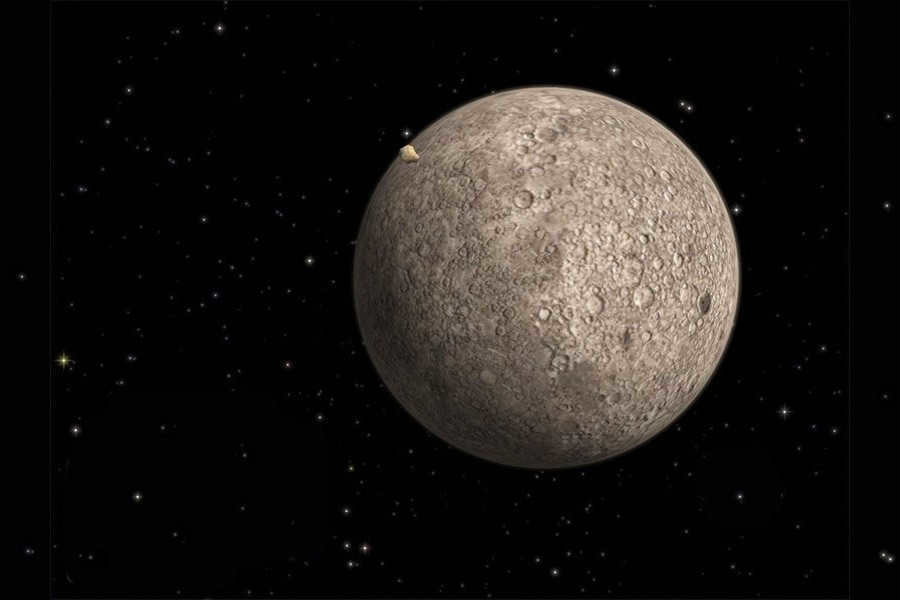
Mercury is often regarded as one of the most enigmatic and least explored celestial bodies within our solar system. Its proximity to the Sun presents numerous challenges for scientists seeking to study and understand its unique characteristics. One of the primary obstacles is the extreme temperature that Mercury experiences, reaching up to a scorching 350 degrees Celsius. This intense heat makes it incredibly challenging for any probe or spacecraft to approach and gather data about the planet.
So, what exactly is Mercury like? Apart from its extreme temperature, this planet is known for its rocky surface, similar to Earth’s moon. Its lack of atmosphere means that it is constantly exposed to the harsh conditions of space, making it an inhospitable environment for any form of life as we know it.
Despite the challenges, scientists continue to study Mercury to unlock its secrets. By exploring its geology, composition, and magnetic field, researchers hope to gain a better understanding of the planet’s formation and evolution. Through such investigations, we may ultimately gain insights into the larger processes that shaped our solar system.

What is the temperature on the tiniest planet in the Solar System?
The temperature on the smallest planet in the Solar System is a subject of curiosity. As we know, Earth is the only planet in the Solar System that supports life. Therefore, the conditions on other planets are vastly different. When it comes to the smallest planet, Mercury, the temperature extremes are quite extreme. During the day, the temperature can reach a scorching 800 degrees Fahrenheit (430 degrees Celsius), while at night it can drop to a frigid -290 degrees Fahrenheit (-180 degrees Celsius). These temperature variations are due to Mercury’s proximity to the Sun and its lack of a substantial atmosphere to regulate heat. So, if you’re ever planning a trip to Mercury, make sure to pack your sunscreen and a heavy coat!
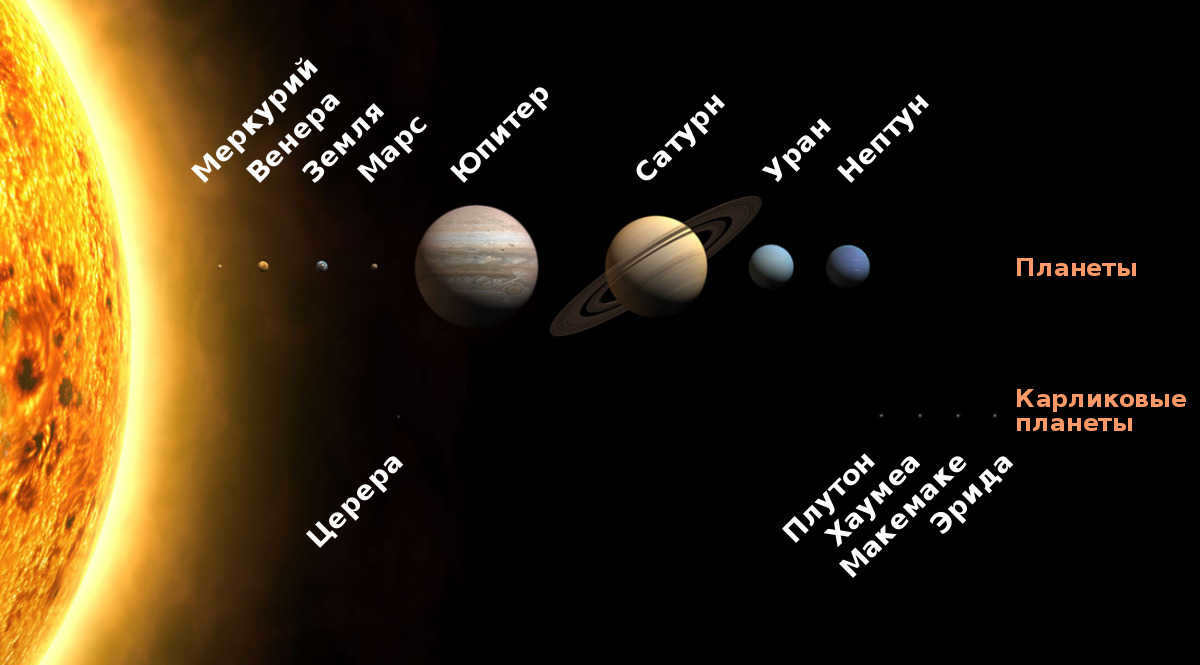
The primary cause for this is the unique characteristics of the atmosphere, or lack thereof, on the neighboring planets, which would provide a habitable environment for living organisms.
Mercury is the least explored among the terrestrial planets within the Earth system, not due to its lack of intrigue.

Exploring the planet Mercury is an extremely challenging task. Its inhospitable conditions make it difficult to access and impossible to conduct any work.

The main factor behind this phenomenon is its position: it holds the title of being the nearest planet to the Sun.
As a result, it experiences the most extreme temperatures in the entire solar system.
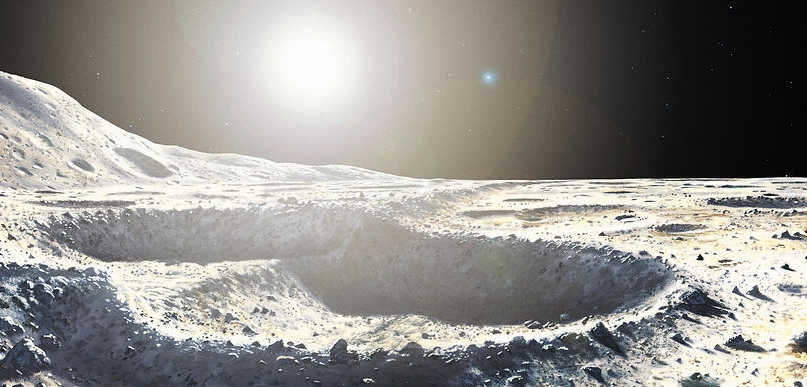
Because it rotates at a slower pace than other planets, Mercury possesses a fragile atmosphere that is unable to retain heat, resulting in extreme temperature fluctuations.

The temperature of Mercury and its rapid fluctuations are unparalleled in space, as no other instances of such jumps have been observed by scientists. On the surface of this celestial body, which is the smallest planet in the Earth system, the temperature can reach over 400°C – an extreme level of heat that is capable of melting various metals including tin, zinc, and lead.

Scientists have been intrigued by the elusive planet for a long time.
Up to now, Mercury has only been explored by two robotic space probes – Mariner 10 in the 1970s, which completed three orbits around the planet, and Messenger.

The spacecraft circled around the relatively unexplored planet, conducting multiple flybys in 2011, and conducting an in-depth study of it for a duration of four years.
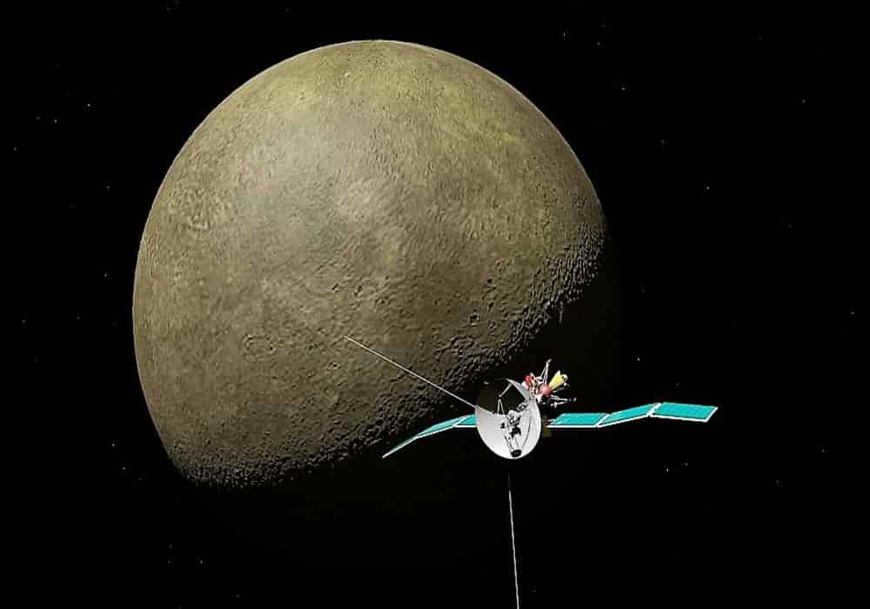
In recent times, significant advancements have been made in the field of Mercury research, leading to a more precise understanding of this planet. Additionally, scientists have uncovered fascinating and unexpected details about Mercury:
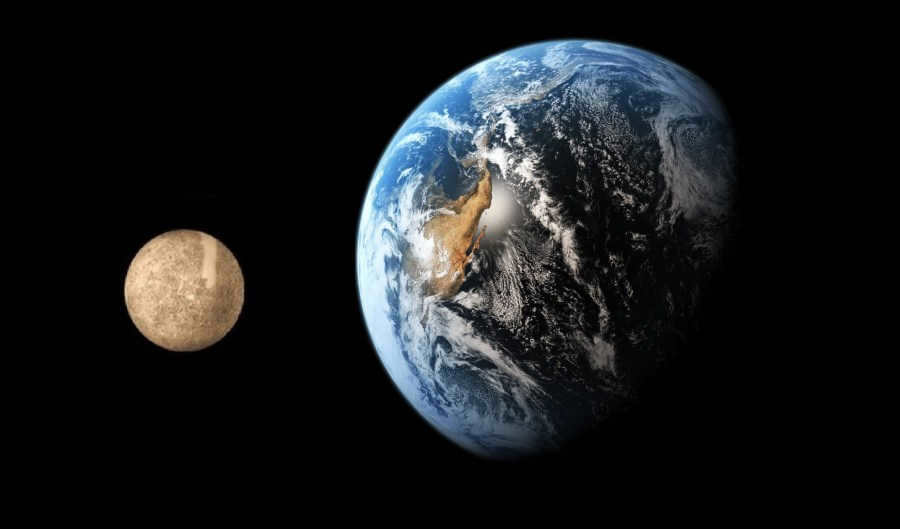
- With a density of 5.4 g/cm³, it holds the second position among the planets in our solar system.

- Water exists on Mercury, but it remains solid and is located deep within craters that are in perpetual darkness.
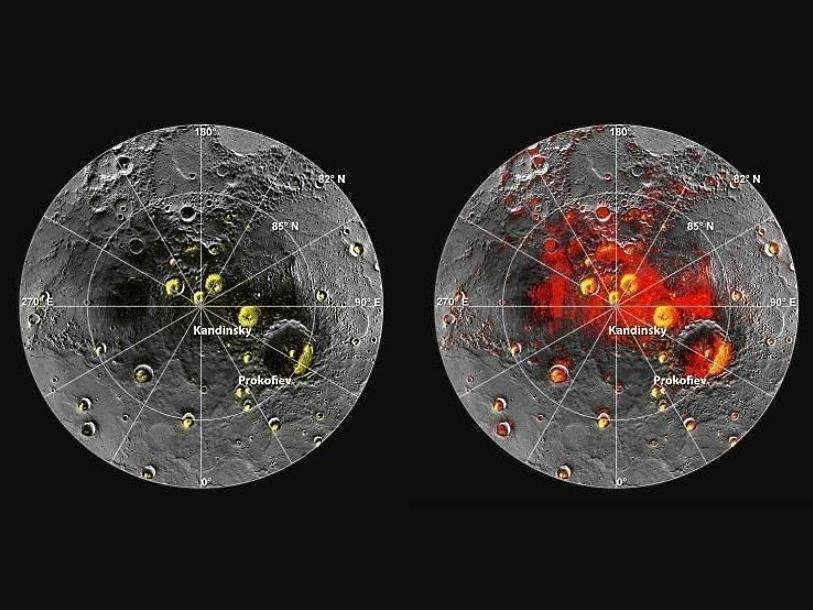
- Merkury has a large iron core that accounts for over 60% of its mass. The outer shell has a relatively thin layer of tough rock, forming a unique crust.
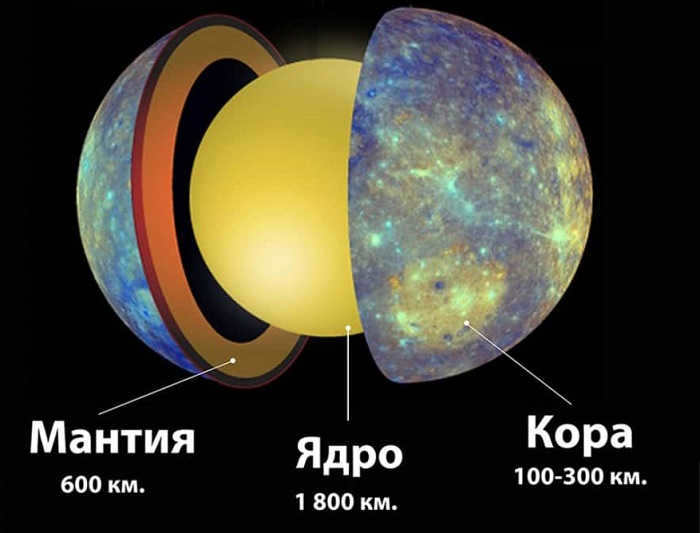
- With the exception of Earth, Mercury is the sole planet in the inner solar system that possesses a magnetic field encompassing its entire surface.

- Merkurij bears a striking resemblance to the Moon, showcasing a plethora of colossal craters scattered across its surface. These craters share a striking resemblance to the ones found on our lunar companion. However, there is a notable distinction: billions of years ago, Merkurij’s surface took shape through a combination of volcanic eruptions, comet and asteroid impacts. Presently, the planet boasts over a hundred active volcano sites.
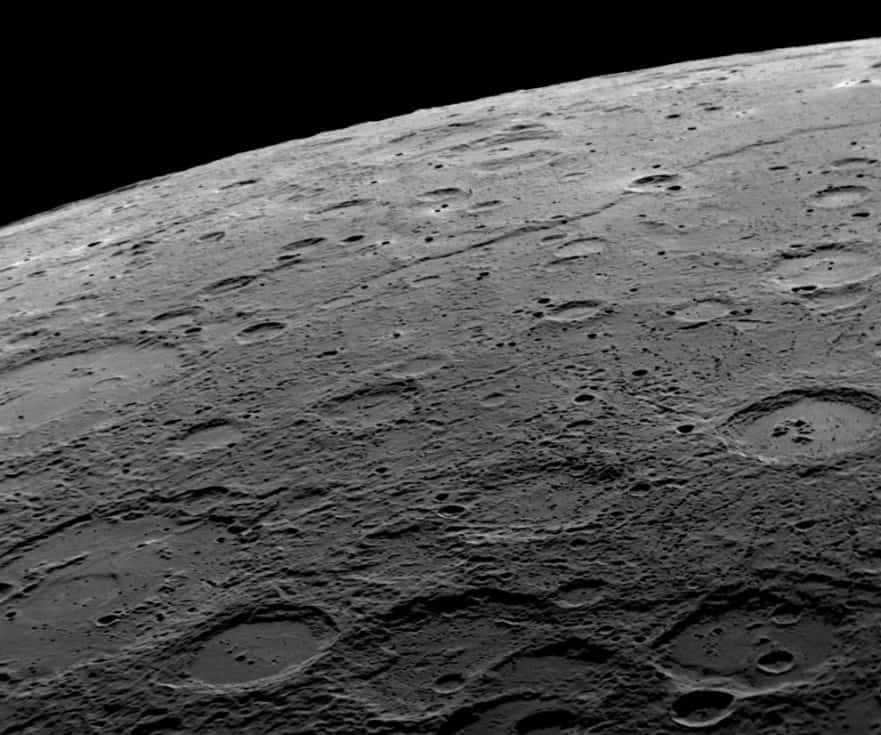
It is believed that Mercury is the sole celestial object in the entire solar system that experiences such extreme temperature changes.
Daily and nightly temperature fluctuations
Despite its close proximity to the Sun, the planet Mercury experiences significant variations in temperature.

However, despite being much closer to the Sun, Mercury is actually colder than Venus. Why is this the case?
Mercury is positioned only about 59 million kilometers away from the Sun.
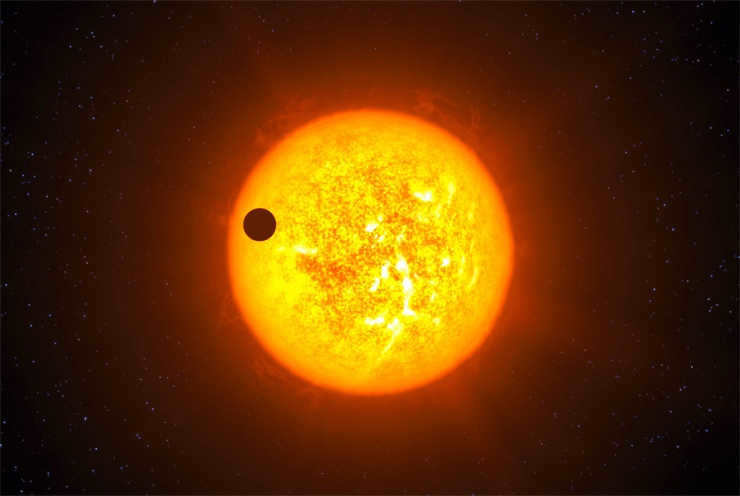
Due to its close proximity to the radiant star, the planet experiences a relatively slow revolution on its axis, and its atmosphere is sparsely populated without any presence of oxygen.

Due to the fragility of Mercury’s atmosphere, it fails to retain heat from the Sun, resulting in extreme fluctuations in temperature. Consequently, the planet undergoes simultaneous periods of intense heat and cold. Specifically, the side of Mercury that faces the Sun becomes heated, while its opposite side is directed away from the Sun and experiences the most extreme cooling.

The surface of Mercury can experience temperatures as high as 427°C (800°F) during the day, but at night, it can drop as low as -269°F (-173°C). These figures are approximate and more precise measurements are still needed for confirmation in the future.

Comparatively, Venus possesses a thick atmospheric “shield” that renders it the most sweltering planet in our solar system! Another noteworthy aspect of Mercury’s climate is its temperature. The outer layer of the planet’s surface is heterogeneous and exhibits low thermal conductivity.

Table showing the composition of Mercury’s atmosphere:

Consequently, at a depth of one meter, the rock’s mean temperature stabilizes at +75°C. Researchers have acquired significant fresh data regarding the composition and structure of Mercury, and have made a remarkable revelation: despite the elevated temperatures, the tiniest planet in the Earth cluster possesses shaded craters where water can exist as a solid.
Changes in Mercury’s Temperature Over Time
During its four-year orbit around Mercury, the Messenger spacecraft captured and transmitted a staggering 270,000 photos, accumulating a total of approximately 10 terabytes of data.

The exploration of Mercury by an American space probe was a groundbreaking endeavor in our scientific understanding of this planet. Through this mission, scientists made a remarkable discovery: the presence of abundant quantities of certain chemical elements on Mercury.
However, this finding was initially met with skepticism due to Mercury’s close proximity to the Sun.
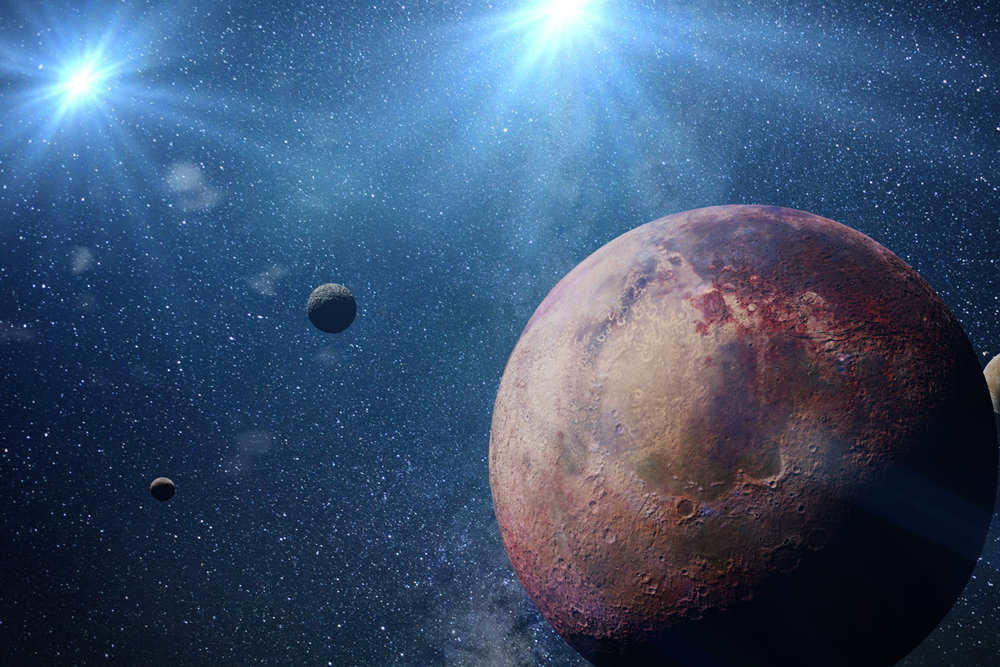
Surprisingly, sulfur and potassium have been discovered on the planet Mercury. This discovery is remarkable, as finding these chemical elements on such a distant planet is considered highly improbable. Moreover, both sulfur and potassium are volatile substances that have a tendency to evaporate easily.
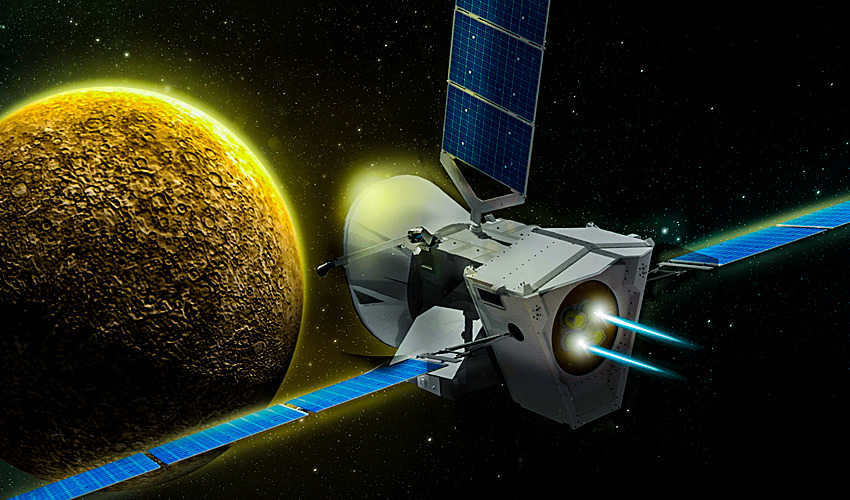
Typically, they can be located in the colder and more northern regions of the solar system. As a result, their detection on Mercury, which is known for its extreme heat, brings up numerous inquiries and forces us to reconsider our understanding of its genesis. Despite undergoing millions of years of shaping and molding, Mercury remains an exceptionally fiery environment.

At regular intervals, it underwent a cooling process, resulting in the formation of a solid outer layer. Over time, this outer layer became enriched with volatile substances that originated from the planet’s interior. However, this process could only occur if Mercury was positioned at a different distance from the Sun during earlier periods. Specifically, it would have been situated 170 million kilometers farther away.

A hypothesis has been proposed by scientists suggesting that approximately 4 billion years ago, Mercury experienced a collision with another celestial body.
As a result of this event, the planet underwent significant loss of its crust and mantle, causing it to shift its position towards the Sun and acquire an elliptical orbit, which remains unchanged to this day.

| Diameter | 4,879 km |
| Orbit | 57,910,000 km |
| Mass | 330,104,000,000,000 billion kg |
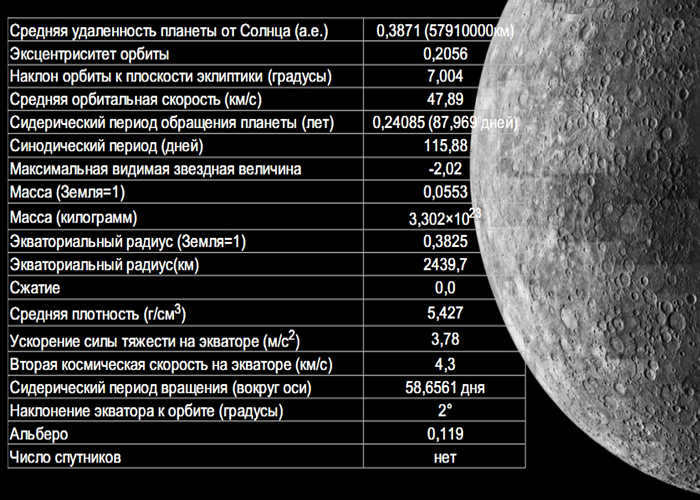
The aforementioned hypothesis appears to be credible, given that the collision is accurate enough to preserve a portion of the volatile substances and prevent their dispersion. When planets collide, they undergo significant heating, resulting in the evaporation of all the volatile substances they possess. Hence, the process of planet Mercury’s formation remains an enigma for everyone.
When we turn our attention back to our solar system, we come across a collection of eight planets, each with their own set of satellites, and at the center, our star, the Sun. In today’s discussion, we will be focusing on the tiniest planet that revolves around the Sun – Mercury. Not only is it the smallest, but it is also the closest planet to our Sun. Its name derives from that of a divine messenger, and the exact date of its discovery remains unknown. Out of the planets visible from Earth, Mercury is one of the five that can be clearly seen. As opposed to the size of the planet Jupiter, Mercury is significantly smaller in comparison.
If you wish to delve deeper into the wonders of this intriguing planet, this article will provide you with all the information you need.

In ancient times, it was believed that the Sun always faced the planet Mercury. Similar to the Moon and Earth, Mercury’s rotation time was believed to be similar to its translation time. It only takes 88 days to complete one orbit around the Sun. However, in 1965, radar pulses were sent to determine that Mercury actually has a rotation time of 58 days. This means that two-thirds of its time is spent in translation. This phenomenon is known as orbital resonance.
Due to its much smaller orbit compared to Earth, Mercury is located very close to the Sun. It is now considered the smallest planet out of the eight planets in the solar system. Previously, Pluto held this title, but it was reclassified as a planetoid, making Mercury its replacement.
Even though it is tiny, the fact that it is so close to the Sun allows it to be visible from Earth without the need for a telescope. Its brightness makes it challenging to spot, but it becomes quite prominent during twilight when the sun sets in the west, and it is easily observable on the horizon.
Main Features

Merkurij is a member of the inner planets group. It is primarily composed of translucent and stony materials, containing a variety of internal compounds. The size of these compounds is remarkably similar. One of its most notable characteristics is its similarity to the planet Venus. Additionally, Merkurij does not have any natural satellites orbiting around it.
The entire surface of Merkurij is comprised of solid rock, making it one of the four rockiest planets in our solar system, along with Earth. Scientists believe that this planet has been inactive for millions of years, and its surface resembles that of the moon. It is dotted with numerous craters, which have been formed through collisions with meteorites and comets.
However, it boasts a sleek and grooved texture with a stone-like composition. These formations can extend for countless kilometers and achieve elevations of one mile. The nucleus of this celestial body is composed of metal and spans approximately 2,000 kilometers in diameter. Certain investigations affirm that its interior is similarly composed of cast iron, akin to our own planet.

Speaking of Mercury’s size, it is a bit bigger than the Moon. It holds the record for the fastest orbit in the solar system due to its close proximity to the Sun.
On the surface of this planet, you can find formations with edges that vary in their state of preservation. Certain craters are more recent, resulting in more pronounced jagged edges from meteorite impacts. Additionally, there are vast basins with multiple rings and an abundance of lava rivers.
Out of all the craters, there is a standout called the Carlori Basin in terms of its massive size. With a diameter of 1,300 kilometers, this crater has the potential to launch projectiles up to 100 kilometers away. The intense and continuous bombardment of meteorites and comets resulted in the formation of mountain rings reaching heights of three kilometers. Given the planet’s small size, the seismic waves caused by the meteorite impact propagated to the opposite end of the planet, resulting in a chaotic and disrupted section of land. Subsequently, the impact led to the creation of flowing rivers of lava.
As a result of extensive cooling and contraction over long distances, the planet’s surface boasts impressive formations of towering cliffs and rocks. This wrinkled crust, reaching several kilometers in height and length, was created through a natural process. The intercrater zone, a term coined by scientists, dominates a significant portion of the planet’s surface. It is believed that these vast plains emerged when ancient regions were submerged by immense lava rivers.
When it comes to temperature, there is a common belief that being closer to the Sun means hotter conditions. However, this is not entirely true. In fact, the temperature on Mercury can reach a scorching 400 degrees in the hottest areas. But due to its slow rotation, many parts of the planet are actually shielded from the Sun’s rays, resulting in cold regions with temperatures dropping below -100 degrees.
Interestingly, Mercury experiences extreme temperature variations throughout its day and night cycles. At night, temperatures can plummet to -183 degrees Celsius, while during the day, they can soar to a scorching 467 degrees Celsius, making Mercury one of the hottest planets in our solar system.
Interesting Facts about the Planet Mercury

- Mercury is renowned for having the highest number of craters in the entire solar system. This is a result of the numerous encounters with comets and asteroids that have impacted its surface. Many of these geological events are named after famous artists and writers.
- The largest crater on Mercury is known as Caloris Planitia, which can span approximately 1,400 kilometers in diameter.
- Some areas on Mercury’s surface exhibit wrinkling, which is a consequence of the planet’s shrinking as its core cools down.
- In order to observe Mercury from Earth, it must be during twilight, either before sunrise or just after sunset.
- By having this information, you can gain a deeper understanding of this incredible planet.
- The content of this article adheres to our editorial ethics guidelines. To report any inaccuracies, please click here.
- Summary of the Full Article: Network Meteorology “astronomy” Planet Mercury

The planet Mercury marks the final destination on our exploration of the solar system’s planets. It can be observed in close proximity to the Sun either before sunrise or shortly after sunset, assuming one can discern its location in the sky. While possessing a telescope is unlikely, it is feasible to catch a glimpse of Mercury with powerful binoculars. Surprisingly, despite their significant variations in mass and size, Mercury and Earth share a nearly identical density.
Distinctive Characteristics of Mercury’s Orbit
Mercury’s orbit sets it apart from the rest of the planets in our solar system due to its elongated shape. Furthermore, it is gradually elongating even more over time. In about five billion years, there is a possibility that Mercury’s orbit might intersect with that of Venus, leading to unpredictable consequences.
The orbital period of Mercury, which refers to the time it takes for the planet to complete one revolution around the Sun, is a mere 88 days. In addition, Mercury rotates on its own axis in just 59 days. This means that a day on Mercury lasts for the majority of its year.
The Surface of the Planet
The planet’s surface bears a resemblance to that of our Moon, as it is adorned with numerous craters. Among them, the largest is known as Rembrandt, boasting a diameter of 716 kilometers. However, what sets Mercury apart from the Moon is the presence of elongated serrated slopes, spanning several hundred kilometers, known as escarpments. These unique features are believed to have formed due to the planet’s compression resulting from its gradual cooling process.
Another intriguing characteristic of Mercury’s surface is the vast Heat Plain, which extends over a distance of 1300 kilometers. This remarkable formation is said to have emerged following a collision with a massive celestial object.
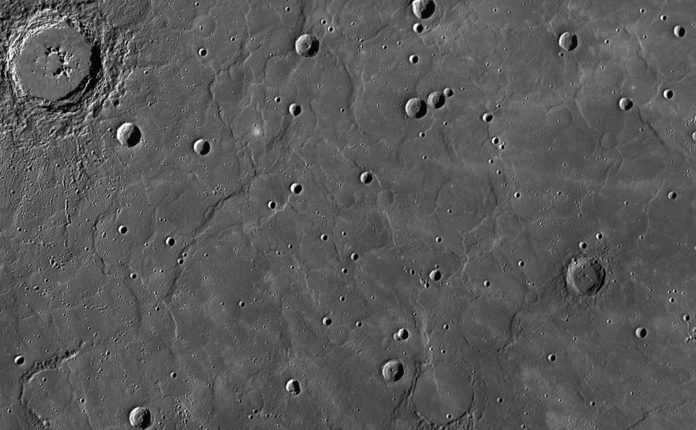
Atmosphere and Internal Structure
Indeed, there is an atmosphere on Mercury, although its presence is attributed to the emission of radioisotopes from the planet’s surface. The constant solar wind effectively blows away these radioisotopes, resulting in an extremely rarefied atmosphere.
Mercury also possesses a magnetosphere, albeit one that is a hundred times weaker than Earth’s and aligned with the planet’s axis of rotation. The magnetic and geographic poles are in close proximity to each other. Due to the challenges involved in studying Mercury, the composition of its core remains uncertain. It is speculated that the core may be in a liquid state due to the Sun’s heating. Furthermore, it is possible that the core contains lighter elements like sulfur, which has a lower melting point than iron, preventing the core from solidifying. However, it is important to note that these are mere theoretical explanations.

The Origins of the Planet
There are various fascinating theories surrounding the creation of Mercury. If you have read my previous article on Venus, you may recall that it lacks any satellites. As a result, one theory proposes that Mercury is a former satellite of Venus. This idea is indirectly supported by the fact that both planets have very slow axial rotations. Through mathematical modeling, scientists have determined that this theory could indeed be plausible.
However, this is not the primary hypothesis regarding the origin of Mercury. The main assumption suggests that Mercury is essentially a planetary embryo that developed a core but did not have enough time to accumulate sufficient mantle and crust before the gravitational influence of larger planets and constant meteor impacts shaped its current appearance.
Traveling to Mercury
If you want to experience the feeling of embarking on a space adventure to the surface of Mercury, you could consider heading to the moon and raising the temperature of the surrounding space to approximately 400 degrees. This would create a similar environment. In terms of picturesque landscapes, however, Mercury is quite unremarkable. With its surface dotted with craters and extreme temperatures ranging from scorching heat on one side to freezing cold on the other, it doesn’t offer much in terms of aesthetic appeal. Nevertheless, standing on its surface would provide an awe-inspiring view of the Sun, although observing it from such a distance might not be as captivating as one might imagine.
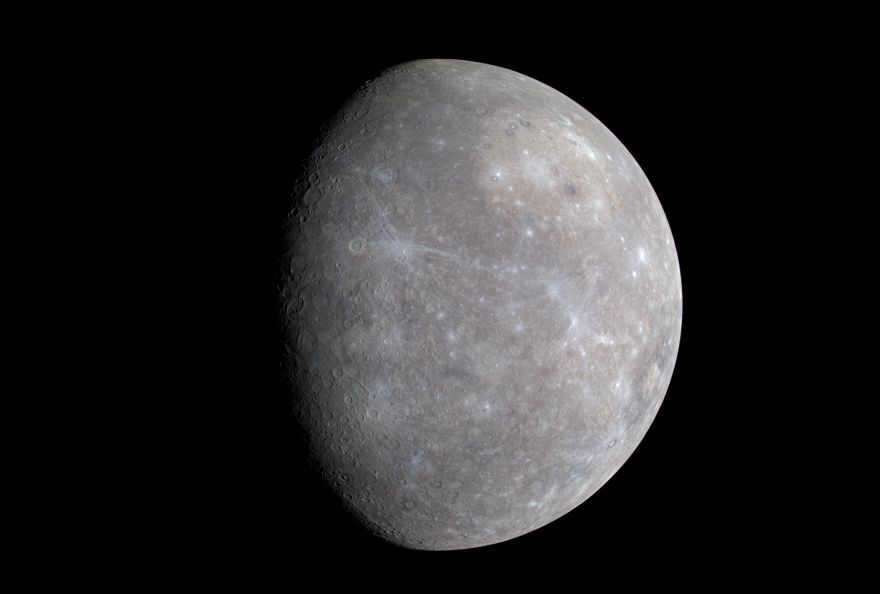
Mercury is the initial planet closest to the Sun and the tiniest planet in the Solar System. It is known for being one of the most extreme celestial bodies. It received its name from the Roman gods’ messenger. It is easily visible without the need for any instruments, which is why Mercury has played a significant role in various cultures and legends. Nevertheless, it remains a highly enigmatic entity. Mercury can be observed during both morning and evening hours, and it exhibits its own distinct phases.
Mercury has a year that lasts only 88 days
– A solar day, which is the time between midday intervals, lasts for 176 days, while a sideric day, which is the time for one axial rotation, lasts for 59 days. Mercury has the highest orbital eccentricity and is located at a distance of 46-70 million kilometers from the Sun.
It is the smallest planet in the solar system
– It is one of the top five planets that can be observed without the need for instruments. It has a diameter of 4879 km at the equator.
Mercury is the second most dense planet in the solar system.
– Each cubic centimeter is composed of 5.4 grams. However, Earth is the most dense planet due to its composition of heavy metals and rocks.
There are surface wrinkles on Mercury
– As the iron core of the planet cooled and contracted, the surface layer developed wrinkles that can span hundreds of miles.
Scientists suggest that there exists a liquid core
– Experts are of the opinion that the iron core may exist in a liquid state. Typically, in smaller planets, it loses heat rapidly. However, it is now believed that it contains sulfur, which reduces the melting point. The core accounts for 42% of the total volume of the planet.
Second highest temperatures
– Despite being further away from the Sun, Venus consistently experiences the highest surface temperatures due to the greenhouse effect. While the day side of Mercury heats up to 427°C, the night side can drop to -173°C. The planet lacks an atmosphere, preventing an even distribution of heat.
Mercury: The Most Cratered Planet
– Geologic processes play a crucial role in rejuvenating the surface of planets and smoothing out the scars left by crater impacts. However, Mercury lacks this capability, resulting in a landscape covered with craters. Interestingly, all these craters are named after renowned artists, writers, and musicians. In fact, impact formations larger than 250 km in diameter are referred to as basins, with the largest one being the Plain of Heat, stretching across a whopping 1550 km.
A Destination Explored by Only Two Spacecraft
– Due to its proximity to the Sun, Mercury poses significant challenges for spacecraft exploration. Only two missions have successfully visited this intriguing planet. The first was Mariner 10, which completed three orbits around Mercury between 1974 and 1975, capturing images of slightly less than half of its surface. The second mission, MESSENGER, reached Mercury in 2004, providing us with valuable insights.
A Name Inspired by Ancient Mythology
– Mercury got its name from the Roman divine pantheon, specifically the messenger of the gods. The exact date of its discovery remains unknown, as the Sumerians documented its existence as early as 3000 BC, making it one of the earliest observed planets in human history.
I believe that Mercury possesses an atmosphere.
– However, due to its low gravity (only 38% of Earth’s gravity), it is unable to maintain a stable atmosphere and it gets destroyed by solar winds. The gas escapes, but it is replenished by solar particles and dust.
The characteristics of the planet Mercury
Mercury has a radius of 2,440 kilometers and a mass of 3.3022 x 10 23 kg, making it the smallest planet in the solar system. In terms of size, it is only 0.38 times the size of Earth. Although it is smaller than some satellites, it ranks second in terms of density after Earth, with a density of 5.427 g/cm 3.

Mercury possesses the most peculiar orbit among all the planets. Its distance from the Sun can range from 46 million km (at perihelion) to 70 million km (at aphelion). The average velocity of its orbit is 47322 km/s, which means that it takes approximately 87.969 days for Mercury to complete one full revolution around the Sun. As for its axial rotation, Mercury spins at a speed of 10.892 km/h, resulting in a day on the planet lasting 58.646 Earth days. This phenomenon indicates that Mercury is in a 3:2 resonance, with 3 axial rotations occurring within the time it takes for 2 orbital rotations. The eccentricity of its orbit and its slower rotation contribute to Mercury taking 176 days to return to its original position. Therefore, a day on Mercury is twice as long as its year. Another notable characteristic of Mercury is its minimal axial tilt, measuring only 0.027 degrees.
Mercury is composed of approximately 70% metallic materials and 30% silicate materials. It is theorized that the planet’s core accounts for roughly 42% of its total volume, which is significantly higher than Earth’s core volume of 17%. The core of Mercury is made up of molten iron, surrounded by a layer of silicate material that spans a distance of 500-700 km. The outermost layer of the planet is known as the crust, measuring 100-300 km in thickness. One notable feature on Mercury’s surface is the presence of extensive ridges that extend for kilometers.
Mercury’s core contains the highest concentration of iron compared to other planets in the solar system. It is believed that Mercury was once a much larger planet, but a collision with a large object caused the outer layers to collapse, leaving behind the core as the main remnant.
According to some theories, it is possible that the planet could have formed in the protoplanetary disk prior to the stabilization of solar energy. In that case, it would have been twice as large as it is now. Under extreme heat of 25000-35000 K, a significant portion of the rock may have vaporized.
Here’s another proposal. The solar nebula might have caused an accumulation of particles that collided with the planet. The lighter ones then drifted away and were not incorporated into the formation of Mercury.
When observed from a distance, the planet resembles a satellite of Earth. It exhibits a similar landscape with craters, plains, and evidence of volcanic activity. However, there is a greater variety of elements present.
Mercury was formed approximately 4.6 billion years ago and experienced bombardment by a multitude of asteroids and debris. Due to the lack of an atmosphere, these impacts left visible marks. Nevertheless, the planet remained geologically active, resulting in the formation of lava plains.

The range of craters on Mercury varies in size, with some being small pits while others are basins that stretch for hundreds of kilometers. One of the largest craters is Caloris, measuring 1,550 kilometers in diameter. The impact of this particular crater was so powerful that it triggered a volcanic eruption on the opposite side of the planet. Caloris itself is encircled by a concentric ring that rises 2 kilometers high. In total, there are approximately 15 large craters scattered across Mercury’s surface.

The planet possesses a worldwide magnetic field that is equivalent to 1.1% of the strength of Earth’s magnetic field. The most likely source of this magnetic field is a dynamo, similar to the one found on Earth. This dynamo is created by the rotation of a liquid core that contains iron.
This magnetic field is powerful enough to withstand the impact of stellar winds and create a magnetospheric layer. Its strength is sufficient to prevent plasma from entering the winds, resulting in the occurrence of surface weathering.
The atmospheric conditions and temperature on the planet Mercury
Because of its close proximity to the Sun, the planet experiences extreme heating, causing it to be unable to retain a substantial atmosphere. However, researchers have observed a tenuous and ever-changing exosphere consisting of hydrogen, oxygen, helium, sodium, water vapor, and potassium. The overall pressure levels are estimated to be around 10-14 bars.
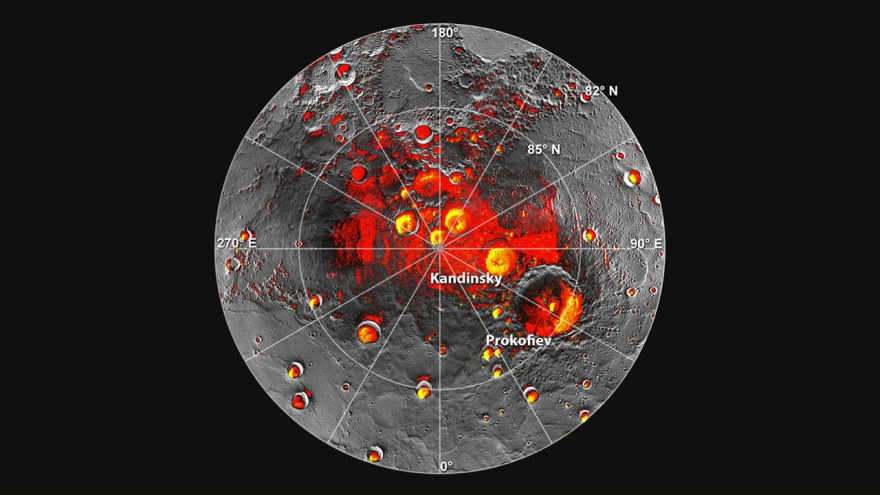
Due to the absence of an atmosphere, Mercury experiences significant temperature fluctuations: reaching up to 427°C on the sunny side and dropping to -173°C on the dark side.
Nevertheless, the planet’s surface contains water ice and organic molecules. This is because the craters at the poles are deep and do not receive direct sunlight. It is estimated that there are 10^14 – 10^15 kilograms of ice present. The exact origin of this ice on the planet is still unknown, but it is believed to be a result of either comets colliding with Mercury or water degassing from the planet’s interior.
History of the exploration of the planet Mercury
The planet Mercury has been a subject of fascination since ancient times, with its visibility to the naked eye making it a prominent figure in myths and ancient legends. The earliest known records of its observation can be traced back to the Moul Apin tablet, which served as astronomical and astrological records in ancient Babylon during the 14th century BC.
These ancient observations described Mercury as the “dancing planet” due to its rapid movement across the sky. In ancient Greece, it was known as Stilbon, meaning “shine,” and was considered the messenger of Olympus. The Romans later adopted this concept and gave it the modern name Mercury, honoring their pantheon of gods.
Ptolemy, in his writings, mentioned the ability of planets to pass in front of the Sun, known as transits. However, he did not include Mercury and Venus as examples, as he believed they were too small and inconspicuous to be noteworthy.
Odin was worshiped by the Germanic tribes, and they believed in a connection between him and owls. In Mayan culture, four owls were observed, with two being associated with the morning and the other two with the evening.
An Islamic astronomer mentioned the geocentric orbital path as early as the 11th century. Ibn Bajya, in the 12th century, made note of two small dark objects passing in front of the Sun, which were most likely Venus and Mercury.

In the 15th century, the Indian astronomer Somayaji of Kerala developed a heliocentric model that included Mercury orbiting around the Sun.
The first recorded observation of Mercury through a telescope was made in the 17th century by Galileo Galilei. At the time, Galileo was focused on studying the phases of Venus and did not have enough magnification power to observe Mercury in detail. However, the transit of Mercury across the Sun’s disk was later observed by Pierre Gassendi in 1631.
In 1639, Giovanni Zupi observed the orbital phases of Mercury. This observation was significant as it confirmed the rotation of Mercury around the Sun and supported the accuracy of the heliocentric model.
Giovanni Schiaparelli provided more precise observations in the 1880s, suggesting that the orbital path of Mars lasted 88 days. In 1934, Eugios Antoniadi produced an elaborate map of the planet’s surface.

In 1962, Soviet scientists successfully repelled the initial radar signal. Three years later, the Americans replicated the experiment and determined an axial rotation of 59 days. Traditional optical observations did not yield any new information, but interferometers unveiled the chemical and physical properties of the subsurface.
In 2000, the Mount Wilson Observatory conducted the first comprehensive examination of surface features. The Arecibo Radar Telescope played a significant role in the mapping process, with its range extending up to 5 km.
Our understanding of the morphological attributes was limited until the inaugural unmanned expedition. The pioneering endeavor was undertaken by Mariner in 1974-1975, which approached the celestial body on three occasions and captured numerous high-resolution photographs.

However, due to its long orbital period, each time it approached, it only covered 45% of the total area.
During the initial approach, measurements of the magnetic field were recorded, revealing a strong resemblance to Earth’s magnetic field, capable of deflecting stellar winds.
In 1975, the spacecraft depleted its fuel and communication was lost. Nevertheless, Mariner 10 continues to orbit the Sun and make visits to Mercury.
The second spacecraft to study Mercury was MESSENGER. Its mission was to study the planet’s density, magnetic field, geology, core structure, and atmospheric features. To achieve this, the spacecraft was equipped with special cameras to provide high-resolution imaging, while spectrometers were used to identify the composition of its elements.
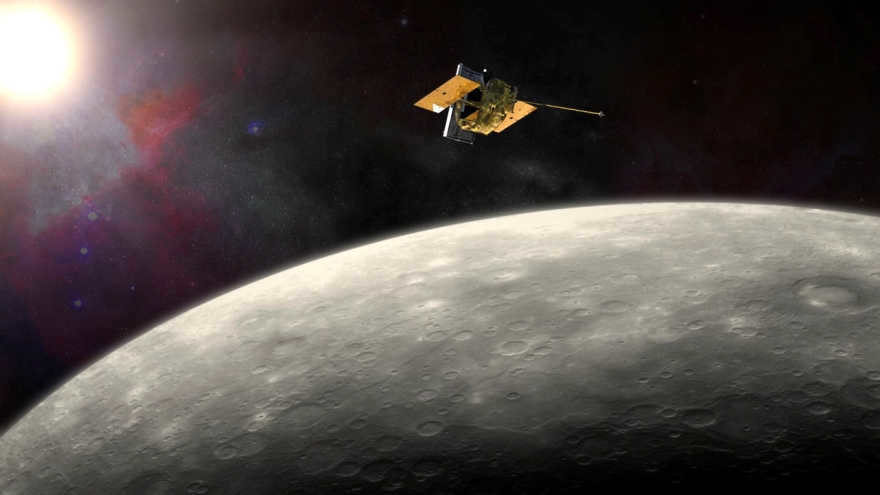
The MESSENGER mission was launched in 2004 and has conducted three flybys since 2008 to explore areas not covered by the Mariner 10 mission. In 2011, it entered an elliptical orbit around the planet and began capturing images of its surface.
Following the MESSENGER mission, a new one-year mission was launched. The final maneuver took place on April 24, 2015. However, the satellite ran out of fuel and crashed into the surface on April 30.
In 2016, the European Space Agency (ESA) and the Japan Aerospace Exploration Agency (JAXA) joined forces to create BepiColombo, which is expected to reach Mercury in 2024. BepiColombo consists of two probes that will study the planet’s magnetosphere and surface in various wavelengths.






